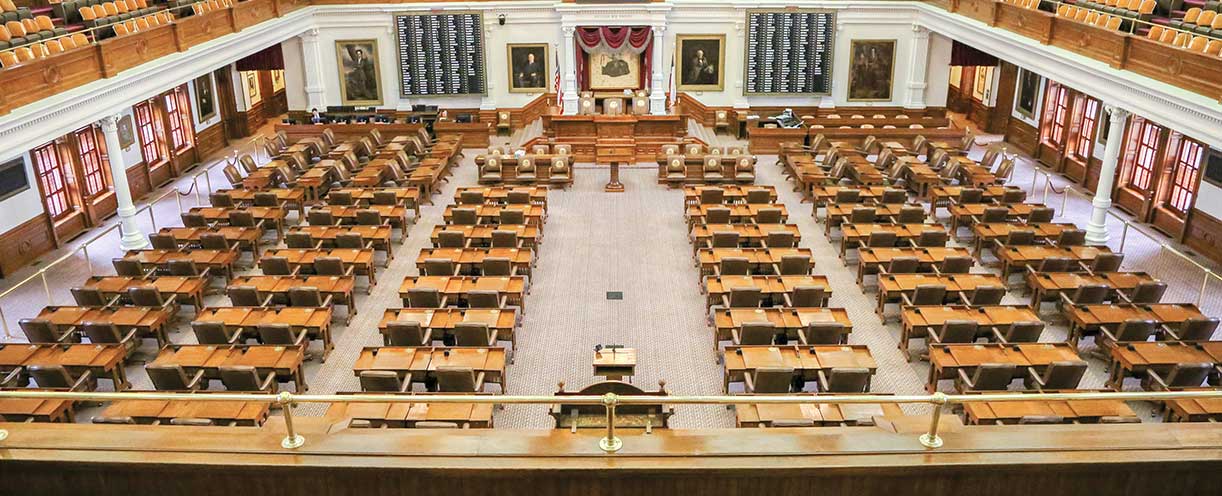A Quick and Easy Look at How the Legislature Works
The Texas Legislature meets every other year for 140 days. With such a brief time to formulate the state budget, new laws, and changes to existing laws, legislators have little time to waste while mapping the future of our state.
This brief primer on the Texas legislative process will help you understand what’s happening and what role you can play.
Division of Power
Much like the federal government, Texas government is divided into three branches:
- Executive: Headed by the governor.
- Judicial: Includes the Texas Supreme Court and all state courts.
- Legislative: Consists of the Texas House and Senate.
What Does the Governor Do?
The governor is the chief executive and is elected every four years. During a legislative session, the governor holds the most power at the beginning and end of each session.
At the beginning, he or she may recommend policies that legislators introduce as bills. The governor can declare certain priorities emergencies, typically during the State of the State speech at the opening of a legislative session. This fast-tracks these items, allowing the Legislature to vote on them within the first 60 days of a session, before other legislation is considered.
The governor also appoints the secretary of state, commissioner of education, and many members of boards and commissions that oversee the heads of state agencies and departments. These offices carry out the laws and direct state policy.
As the session comes to a close, the governor’s constitutional job description includes signing or vetoing bills. More on this later.
Who Leads the House?
On the first day of each regular session, the 150 members of the Texas House of Representatives choose one of their members as speaker of the House.
Whoever sits in the speaker’s chair will be presiding officer of the House and will keep order, recognize members to speak during debate, and rule on procedural matters. Because he or she is a member of the House, the speaker may vote at any time or withhold action to cast the deciding vote in a tie.
The speaker appoints committees, committee chairs, and vice-chairs. Representatives, who serve two-year terms, can work on up to three committees.
And in the Senate?
The lieutenant governor is the presiding officer of the Senate and is chosen by voters, not the 31 senators. The lieutenant governor is the second-highest-ranking officer of the executive branch and, like senators and the governor, is chosen for a four-year term. The lieutenant governor cannot vote on legislation unless there is a tie or when the Senate convenes as a committee of the whole.
The first thing the speaker and the lieutenant governor ask the two houses to do is decide on the rules they will follow during the session. The Texas Constitution provides some legislative procedures, but both chambers can adopt additional rules if they are approved by a majority vote of the members.
Introducing Bills
After rules have been adopted, the Legislature starts to consider bills, which are proposals to change state law by adding a new law or amending a current one.
Ideas for bills come to representatives and senators from many sources:
- Constituents
- Interim committees of the House or Senate
- Associations such as TASB.
- The Legislative Council, an agency that provides legislators bill-drafting services and research assistance, often helps draft proposed legislation
Once a bill has been written, a member of the House or the Senate introduces it. A representative and a senator working together sometimes introduce similar bills in both houses at the same time. Any bill increasing taxes or raising money for use by the state must start in the House of Representatives.
After a bill has been introduced, a short description of the bill, known as the caption, is read aloud while the chamber is in session so that all members are aware of the bill and its subject. This is the first reading. At this point in the process, the presiding officer assigns the bill to a committee, and this assignment is announced on the chamber floor during the first reading of the bill.
Committees
The chair of a committee decides when the committee will meet and which bills it will consider.
House committees have three kinds of meetings:
- Public hearings, where testimony is heard and where action may be taken
- Formal meetings, where members may discuss and take action without hearing public testimony
- Work sessions for discussion without action
In the Senate, testimony may be heard and official action may be taken at any committee meeting. Public testimony is usually sought on bills so that citizens have the chance to provide input. Legislative witnesses also include representatives of other levels of government like county officials, mayors, school board members, and other subject matter experts.
After considering a bill, a committee may take no action or may issue a report on the bill. The report expresses the committee’s recommendations regarding action on the bill and usually includes a record of the committee’s vote, the committee’s version of the bill text, an analysis of the bill, and a fiscal note estimating the costs, savings, revenue gain, or revenue loss resulting from implementation of the proposed legislation.
In the House, the committee report goes to the Committee on Calendars for placement on a calendar for consideration by the full House. In the Senate, bills are placed on the agenda in the order in which they were reported from a committee.
Action on the Floor
A bill receives a second reading when it comes up for consideration by the full House or Senate. The bill’s caption is read, and the bill is debated by the full membership of the chamber. Any member may offer an amendment, which must be approved by a majority of the members present. Members then vote on the bill.
The full body then considers the bill again on third reading and final passage. Bills may be amended again on the third reading, but amendments require a two-thirds majority for adoption at this stage.
The Texas Constitution requires a bill to be read on three separate days in each house before it can have the force of law, but this rule may be suspended by a four-fifths vote of the chamber considering the bill. The Senate routinely suspends this constitutional provision to give a bill an immediate third reading after its second reading consideration. The House rarely suspends this provision. A third reading of a bill in the House normally occurs on the day after its second reading.
When a bill receives a majority vote on the third reading, the bill is considered passed. When a bill is passed in the chamber where it originated, the bill is engrossed, and a new copy of the bill that incorporates all corrections and amendments is prepared and sent to the other chamber for consideration. There, the bill follows the same process for that body. When the bill is passed there, it is returned to the originating chamber with any amendments that have been adopted attached to the bill.
If a bill is returned to the originating chamber without amendments, it is signed by the speaker and the lieutenant governor and sent to the governor.
If a bill is returned to the originating chamber with amendments, the originating chamber can agree to the amendments or request a conference committee to work out the differences in the two versions of the bill. If the amendments are agreed to, the bill is signed by the speaker and the lieutenant governor and sent to the governor.
Conference committees are composed of five members from each chamber appointed by the presiding officers. Once the conference committee reaches agreement, a report is written and must be approved by at least three of the five conferees from each chamber.
Conference committee reports are voted on in each house and must be approved or rejected without amendments. If approved by both houses, the bill is signed by the presiding officers and sent to the governor. At this point, the bill is considered enrolled.
The Governor’s Options
When the governor receives a bill, he has several choices:
- Sign it
- Veto it
- Allow it to become law without a signature
If the governor vetoes a bill and the Legislature is still in session, the bill goes back to the chamber where it originated with an explanation of the governor’s objections. A two-thirds majority in each house is required to override a governor’s veto.
If the governor neither signs nor vetoes a bill within 10 days, it becomes law. If a bill is sent to the governor within 10 days of final adjournment, the governor has until 20 days after final adjournment to sign the bill, veto it, or allow it to become law without a signature.
Constitutional Amendments
Proposed amendments to the Texas Constitution are in the form of joint resolutions. Joint resolutions must be approved by two-thirds of the entire membership in each chamber.
Joint resolutions are not sent to the governor but are filed with the secretary of state. Voters must approve amendments to the Texas Constitution.
Resolutions are statements of opinions and, unlike bills, do not have the force of law. In addition to join resolutions, there are concurrent resolutions and simple resolutions.
Concurrent resolutions are usually expressions of the Legislature’s feelings on a subject, instructions to state agencies, or proposals to set up a special study of some issue during the interim between legislative sessions. Both the House and Senate must adopt concurrent resolutions.
Simple resolutions are commonly expressions of the Legislature’s sympathy upon a death or congratulations to an individual or group for an accomplishment. Only the chamber in which simple resolutions originate considers those resolutions.
This article was originally published on Feb. 23, 2021, and has been updated.





